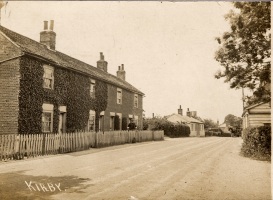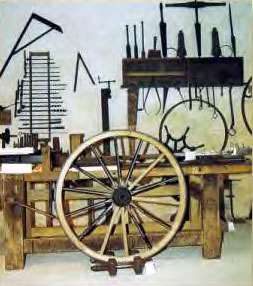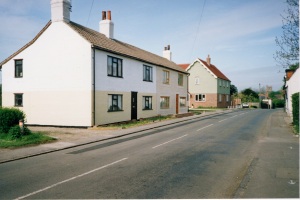The Burgess Family - Kirby's Wheelwrights

The Burgess Family - Kirby's Wheelwrights |
 |

Close your eyes and listen to the sounds of times long gone. Sounds of old Kirby, the ringing of the smith's hammer as he forces the hot metal into shape. The rhythm of horses hoofs pounding on the road and the click clacking of the carts newly laden with goods just unloaded from the barges moored in Kirby Quay and that ocassional high pitched screeching of badly oiled carriage wheels, a sure sign that the Wheelwrights skills would soon be needed.
For almost a hundred years the Burgess family were wheelwrights here in Kirby-le-Soken. Choosing the right oak, elm and ash. Cutting and storing it till it was properly seasoned and ready to put to use in making and repairing wagons, carts and wheelbarrows including of course the all important wheel. Perhaps also taking in sundry smaller carpentry jobs for their neighbours - a new handle for the bakers paddle or a plough for the local farmer.
On the seventh of August 1799 in the reign of George III, William Burgess took up his quill to sign his last will and testament. A widower now probably in his 70s, William the wheelwright was putting his affairs in order watched by witnesses Judith Annis, Joseph Warbroom and William Manson. He appointed local farmer Mr.Henry Draper executor bequeathing:

Ten years later at the age of 86 William snr. died and was laid to rest close to the walls of St. Michaels the parish church. So it fell to William jnr. to carry on the family business while brother Daniel was working in the same trade in St. Osyth where John also earned his living making shoes.
William Burgess, who was born 1757 in Kirby-le-Soken, and his wife Ann had six children that we know of. Their eldest child Ann born in 1785 died the next year. The first born boy born 1790 was of course named William - the family legend says that the Burgess house bore a plaque with the motto: From William to William, from father to son, while rivers flow and waters run.
The birth of young William was followed by another daughter, Elizabeth Turpin, in 1795, Mary Ann 1799 who eventually married William Cousins of Great Bentley, then Edward and John. After Ann and son John died, William married Susanah Mason in 1816. Wheels turned and the work went on making the hub for the wheels out of dense elm, shaving the spokes of the wheels from the mighty oak for strength and then the felloes (pronounced fellies) sections of curved ash that made up the rim. Time now perhaps to cross the road to the Smithy where the wheel was shod like the horses or maybe William did his own iron work in his wheelwrights shop. The 'shoes' were strips of iron curved to fit over the joints in the felloes but not quite joining together. In later years the wooden wheel would be given a complete iron tyre pulling the joints close together. And William seemed to prosper, that's if the parish clerk had his facts right, for in 1818 he consulted solicitors Sparling and Witty of Colchester about the possibility of taking William Burgess to court.
William's daughter Elizabeth Turpin married James Davy a labourer in 1813. By 1818 the couple were, for reasons unknown, in financial trouble. To help support Elizabeth and their three children James, William and Mary Ann, James Davy had been claiming Parish Relief of 12 shillings a week and upwood and the Parish thought it was about time William Burgess contributed to his daughter and grandchildren's upkeep. In the documents it's stated that William Burgess, Master Wheelwright, owned the following property:
Furthermore William was supposed to have money out at interest and had offered to lend the said Overseer a sum of £200-£300 just a few months earlier. So far we have found no record of the outcome of this situation but as the Daveys already appeared to be living rent free, perhaps William agreed to give them more support.
William the third had expanded the business into nearby Weeley and it was from here that he married Sussanah Bird in Great Clacton on 14th March 1815. The birth of their first son and William broke with tradition naming him John Richardson. He was swiftly followed by Sussanah 1817, Mary Ann 1820, William 1822 and Robert in 1824. When William's father died suddenly on 25th March 1825, the family moved back to Kirby. William once more working in the family Wheelright shop. More children followed; Joseph was born in 1826, Sarah Ann in 1828, Frederick in 1830 and Edward in 1832.
By now John Richardson was training in the wheelwrights craft but tragedy struck and John died on the 12th November 1833. The next child was named after his brother but did not live long. John Richardson number three was born in 1837. When Frederick died in 1839 another son soon followed and was promptly named Frederick.
The 'hungry forties' brought hard times to the countryside and gradually the Burgess boys migrated towards London. By 1841 William now trained as a wheelwright and Robert who was skilled in work of the smith had left home. When William third died in August 1856, two years after his wife, Joseph, John Richardson and Frederick joined their brothers coachmaking in London. As for the girls Susannah married Jerimiah Carter of Nayland. Sarah Ann married Joseph Cook a shoemaker and Mary Ann was still unmarried in 1851.
So ended the Burgess connection with Kirby-le-Soken and a new very different life started in London and in case you are wondering William's eldest son and grandson were both baptised William. John Richardson proved to be an unlucky name - his first wife died of typhoid fever aged 26 and John died aged 29 of smallpox just 4 months after remarrying. Frederick named his son after his brother but this John Richardson also died of smallpox aged 11 months.

With the departure of the Burgess brothers went a hundred years of knowledge not only of the Wheelwright's skills knowing how to produce good stong carts that were at the same time shaved wherever possible for minimum weight, how to curve the shafts so that they didn't chaff the horses shoulders and how to manufacture the perfect dish shaped wheel, but also of local knowledge of where the best trees were to be found, how certain conditions in certain areas could produce just the right curves in the trunk. Of what the land was like on individual farms and what subtle differences were needed to make the hay wagons etc. best work there. Not to mention the likes and dislikes of local farmers and tradesmen. No more did the sounds come from their Wheelwrights shop. No more thuds as the spoke was driven into the hub of the wheel, nor the sounds of the axe and draw-shave shaping up the spokes and no hissing as water was poured onto the red hot iron to stop it burning the wheel. Just silence in the Burgess Wheelwright shop.

This page was researched and written by Vic Burgess and Sheila Bound.
They welcome any communication about this article and the Burgess family living in North East Essex during the 17th and 18th Centuries.